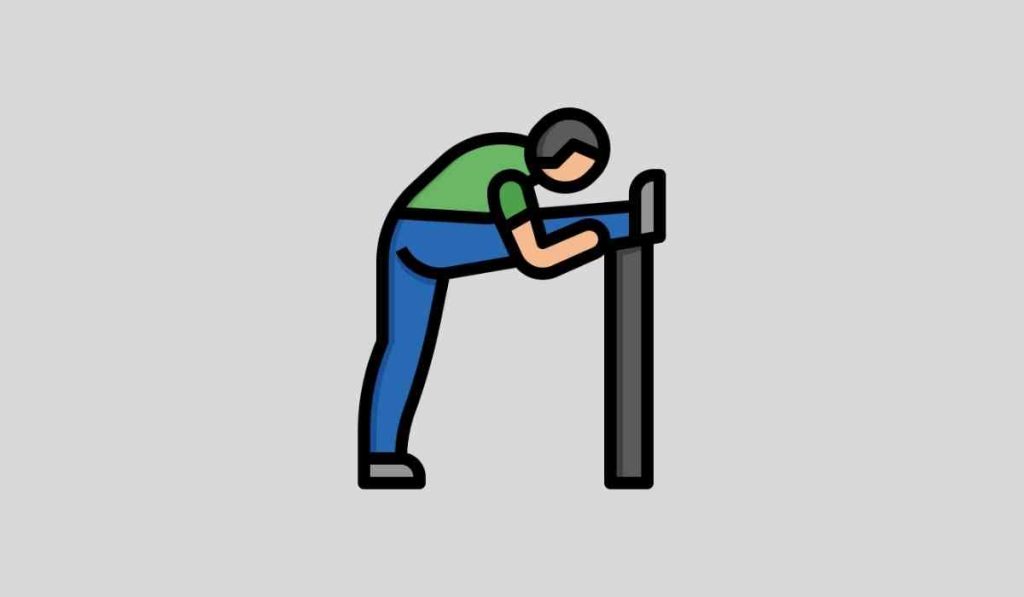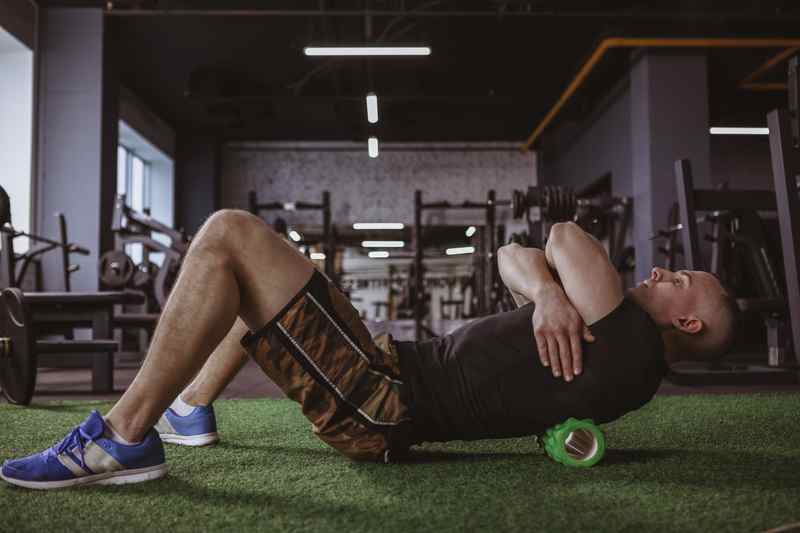Improving your flexibility takes time. Here’s how long, the different kinds of stretching to use, and why you should spend every day working on becoming more flexible.

I’m not going to lie: there are few things I hate more than stiff, tight joints!
We’ve all had those days when we’re looking forward to some sports competition or hardcore workout, but when the time comes to actually get training, we can’t move as well as we’d like.
Maybe our knees are stiff and achy, our lower back is acting up, or our hips just don’t flex and twist quite as much as we feel they should.
That’s one of the greatest problems with our modern lifestyle—thanks to all the time we spend sitting on our butts, our natural flexibility and mobility decreases, so we can’t move as efficiently as our bodies are intended to.
But you can combat the inevitable stiffness and inflexibility! It’s going to take some serious, focused flexibility training, but with enough time and effort invested, you can see results.
The question is, though, how long does it take to improve flexibility? Are we talking days, weeks, months, or years?
Below, I’ll take the time to look at flexibility/mobility, what it is and how it benefits you, as well as the types of training available to help improve your flexibility.
I’ll also answer the question of “How long do I need to train to become more flexible?” so you have a clear idea of just how much time and effort it’s going to require from you.
What is being “flexible” and what are the benefits?
Before we get into talking about leg day stretches or extol the virtues of upper body dynamic stretches, it’s important for us to take a minute to look at the reasons why you should be doing these stretches.
And it all comes down to two critical elements of fitness: flexibility and mobility.
“Flexibility” refers to your ability to extend your muscles and joints to a certain extent.
For example, some people can bend their thumbs far enough to touch their wrists, or they can spread their legs wide enough apart to do the splits. Flexibility is passive—it takes the exertion of outside force (i.e., gravity, your other hand/leg, etc.) to push your body to full extension.
“Mobility”, on the other hand, refers to your ability to actively move itself to full extension.
For example, someone who can do a standing split and kick directly over their head has excellent mobility.
Their muscles are naturally moving their body to the full extension, rather than outside force being exerted.
There are a lot of reasons that you want both greater mobility and flexibility.
Here are just some of the benefits of stretching:
Lower injury risk. When you can move through a broader range of motion without tension in your muscles, joints, and soft tissue, you are far less likely to suffer an overextension injury—such as ankle sprains, shoulder hyperextensions, or jammed fingers.
You’re also less prone to back injuries if your spinal column can move through a fuller range of motion without straining the tissue and muscles supporting the vertebrae1.
Better posture and balance. Better posture typically means you can stand in the way that your body is designed to, which leads to A) more efficient movement, and B) less pain.
Flexibility and mobility also contribute to better balance, so you’re less likely to stumble and fall (a common cause of injuries) whether you’re playing sports or just going about your daily life.

Greater strength. Greater flexibility and mobility also contributes to greater strength in a wider range of positions2.
Remember that your muscles can only be trained to the extent that your body can move. The more your body can move—through squatting, lunging, pressing, and pulling positions—the greater variety in your strength training, and the more overall strength!
Less pain. Pain is your body’s signal that something is wrong—either something is moving that shouldn’t be, or isn’t moving enough. Flexibility and mobility training can do wonders to reduce pain and ensure smooth, efficient movement.
Healthier aging. As you age, you’ll naturally lose both strength in your muscles and mobility/flexibility in your joints. It’s just a side-effect of the physiological aging process!
But specifically focusing on mobility/flexibility training can help to combat this natural deterioration and maintain healthy, efficient movement well into your later years.
Types of Flexibility Training
Flexibility training goes beyond just the various types of stretching!
In fact, there are a lot of different flexibility and mobility-focused training modalities that you can use to improve your movement:
? Ballistic stretching involves using the momentum of your body or a limb to force it beyond its normal range of motion. For example, kicking your legs high over your head to stretch out your glutes/hamstrings.
Fair warning: this type of stretching is considered “less useful” because it not only won’t encourage the muscles to relax properly, but can actually cause them to tighten up and further reduce mobility.
? Dynamic stretches involve moving your body in a way that gradually increases your flexibility and mobility.
Some of the best dynamic stretches include, for example, walking lunges, torso twists, standing hip circles, and shoulder rolls.
These are considered among the most effective stretches to increase mobility and flexibility.
? Static stretches involve holding your body in a static position at or slightly beyond the “tension point” in your range of motion.
These are considered less effective (and less safe) than dynamic stretches, but combining the two can be a highly effective means of lengthening and strengthening your joints at the same time.
? Isometric stretching involves isometric contraction of the muscles in a stretched position—for example, pushing your leg against someone holding it at full extension, or pushing off a wall.
This type of stretching not only increases the range of motion, but is highly effective at activating (and thereby strengthening) your muscles in a stretched position.
? PNF (proprioceptive neuromuscular facilitation) stretching involves a combination of isometric and static stretching in a sequence of stretching-and-relaxing movements that leads to significant improvements in passive flexibility (though it’s not as effective for mobility). (See more on the benefits of PNF stretching here.)
? Foam rolling isn’t a type of stretching, but instead uses stiff foam objects in a cylindrical or spherical shape (rolling pin, ball, massage stick, etc.) to self-massage tight or tense muscles and connective tissue.
Using a foam roller is an excellent way to work out knots (such as in your shoulders or lower back), but also to loosen up your joints and increase your range of motion.
There are a lot of benefits of foam rolling, and studies have found that it’s highly effective at improving mobility and flexibility both when paired with dynamic and/or static stretching.
Amazing, isn’t it? With so many types of flexibility training to choose from, you’ve got many different paths to greater fitness and healthier overall movement!
How Long Does it Take to Improve Flexibility?
Now we come to the real heart of the matter, the question that brought you here in the first place.
You want to know how long it takes to improve your flexibility, to increase your body’s ability to move through its full range of motion.
Well, I’ve got good and bad news for you…
Let’s start off with the good!
According to a variety of sources, you can expect to see real results in your flexibility and mobility within 2-6 weeks, depending on the type of training you do.
- With static stretching, for example, you’ll probably take a lot longer to notice improvements because your body will only be more flexible in the positions you are training.
- With dynamic training, PNF training, or foam rolling, you’ll usually start seeing better, easier movement within 2-3 weeks, and real visible improvements by the 6-week mark.
Of course, this is all predicated on your spending 5 days per week in flexibility training (at least 10-15 minutes per day).
And this is where I have to talk about the bad news…
Flexibility – Use it or Lose It
If you don’t spend enough time training your flexibility, you’ll actually start to lose it.
That’s right, without at least 2-3 training sessions a week, you’ll notice increased stiffness in your joints and muscles within a matter of days—7 to 10, to be precise.
Any progress you might have made with your training will be eliminated as your body naturally tenses/stiffens up due to inactivity.
This means flexibility training needs to be your new way of life!
Mixing in flexibility training alongside your regular strength and cardio workouts is the key to improving your mobility and flexibility, not just for the short-term, but for the rest of your life.
As you saw above, you’ll be more resistant to injuries, have better balance, develop greater strength, and experience less pain.
It’s worth putting in the time and effort if it means a better quality of life overall!
Improving Flexibility FAQs
Why do I feel less flexible some days compared to others?
There are a lot of reasons, some of which include:
- Higher levels of stress (increasing muscle/joint tension)
- Recovery from injury (even micro-injury you didn’t feel at the time)
- Reduced movement the day before leading to increased stiffness/tension
- Muscle fatigue causing more tightness
- Overstretching/overextension causing tears in the muscle and joint fibers
- Hormones (particularly estrogen, immediately preceding a woman’s period) affecting your range of motion
All of these things can contribute to reduced flexibility on certain days.
The good news, though, is that it’s not a cause for concern. Keeping up with your daily stretching routine will be more than enough to work out any kinks and loosen any tight, tense muscles.
Can I stretch multiple times per day to improve flexibility?
You absolutely can! As we explained above, stretching builds muscle and helps to loosen up soft connective tissue.
However, because there’s no actual damage to the joint tissue, there’s no need for a lengthy recovery time like there is with muscle fibers. That means you can spend hours every day training for flexibility without negative side effects.
It’s only if you overstretch, over-extend, or push your body beyond the point of fatigue that you’ll do damage to your joints. As long as you’re stretching cautiously and safely, you can stretch as many times per day as feels right to you!
What are the best programs for improving flexibility?
There are plenty of free resources for improving flexibility, but if you have a very specific goal of improving range of motion and flexibility ASAP, one of my favorite stretching programs is from Alex Larsson, M.S.
It’s a self-paced digital program that helps beginners and experienced “stretchers” alike.
Hyperbolic Stretching is less than $30, has clear, detailed videos and instructions for every stretch, and also has a ton of different routines and programs for different goals.
Upper body stretching routine? Yup. A program for doing the front splits? Yup.
Learn more about Hyperbolic Stretching in my full and detailed review here.
The Bottom Line
Stretching isn’t just a “good idea”—it’s one of the best things you can do to ensure healthy, agile movement for the rest of your life!
Mobility and flexibility is one of the four critical components of fitness, and it’s just as important as strength training and cardio.
Make a point to include it into every workout—at both the start as a warm-up and at the end as a cool-down—and you’ll see visible improvements in your conditioning and your ability to move naturally and free of pain.
More Stretching Resources
Stretching Routine for Front Splits: Stretches, Tips, and Step-by-Step Instructions. Master the front splits with this stretching routine that you can do anywhere. Includes step-by-step instructions, muscles stretched, safety tips, and more.